Operations and Project Management Report: Tesco, Midlands Analysis
VerifiedAdded on 2022/11/28
|15
|4073
|382
Report
AI Summary
This report provides a comprehensive analysis of operations and project management, exploring key principles and strategies through the lens of real-world examples. Part A focuses on operational management, examining the implementation of operational principles within Tesco, including inventory management and resource optimization. It delves into continuous improvement plans, highlighting strategies like lean production and Six Sigma, and analyzes their effectiveness using theories like lean principles and the PDCA cycle. Part B shifts to project management, examining the stages of the project life cycle within a Midlands-based manufacturing organization facing a catering service challenge. The report covers project initiation, planning, execution, monitoring, and closure. The report also provides recommendations for improvement, emphasizing the importance of reducing waste, building strong customer relationships, and effectively applying the PDCA theory for continuous development. The report showcases how operational and project management principles can be applied to enhance efficiency and achieve organizational goals.
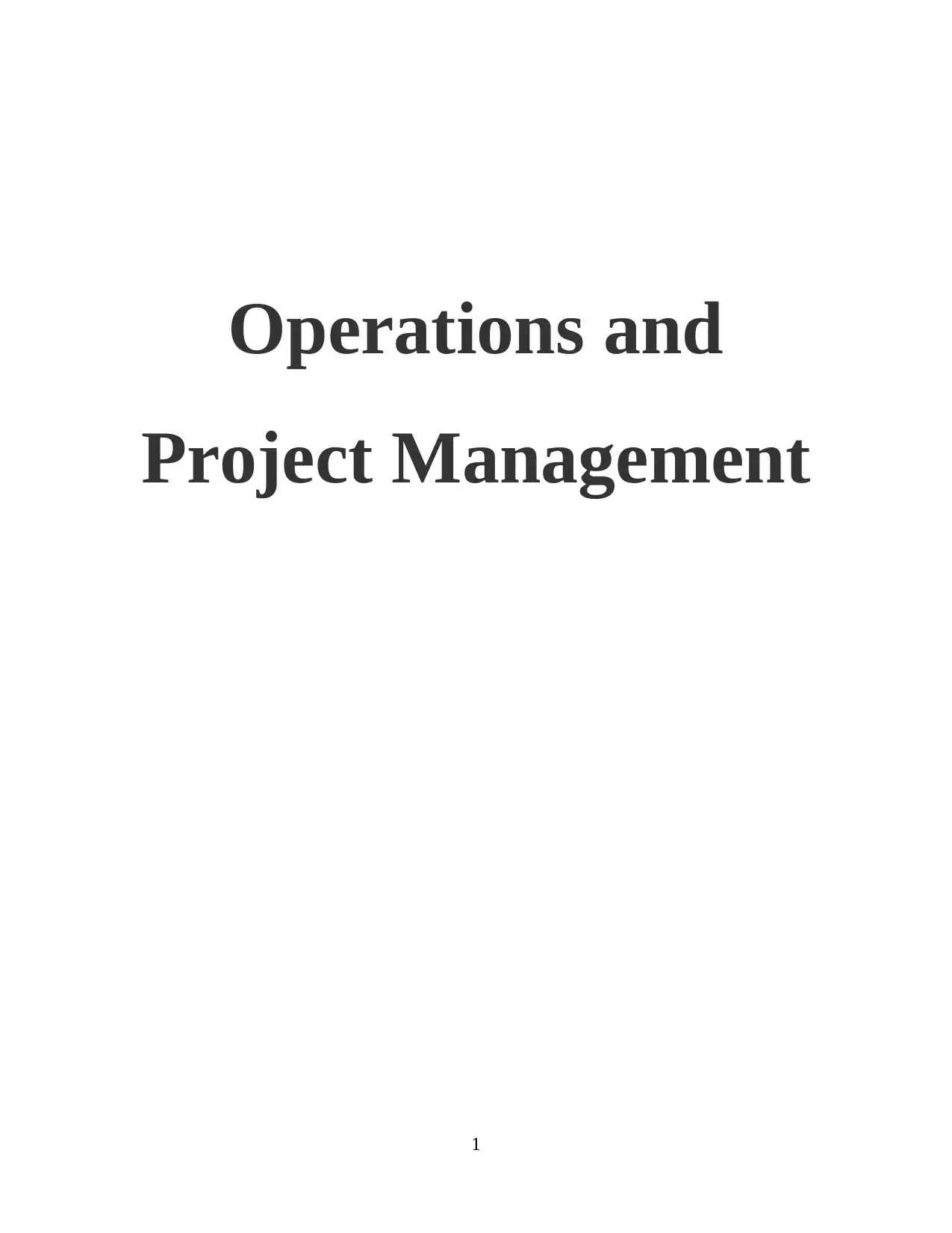
Operations and
Project Management
1
Project Management
1
Paraphrase This Document
Need a fresh take? Get an instant paraphrase of this document with our AI Paraphraser
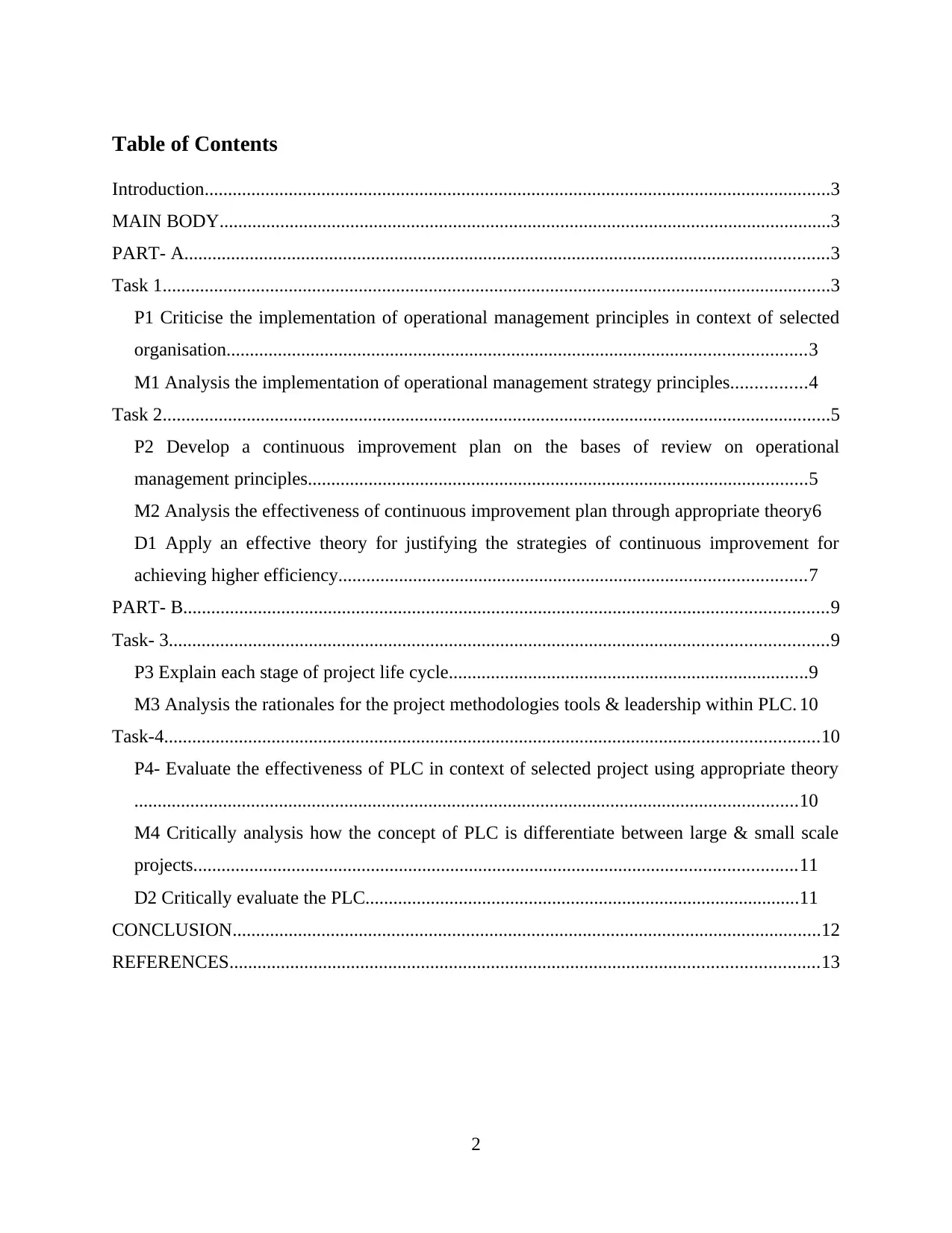
Table of Contents
Introduction......................................................................................................................................3
MAIN BODY...................................................................................................................................3
PART- A..........................................................................................................................................3
Task 1...............................................................................................................................................3
P1 Criticise the implementation of operational management principles in context of selected
organisation............................................................................................................................3
M1 Analysis the implementation of operational management strategy principles................4
Task 2...............................................................................................................................................5
P2 Develop a continuous improvement plan on the bases of review on operational
management principles...........................................................................................................5
M2 Analysis the effectiveness of continuous improvement plan through appropriate theory6
D1 Apply an effective theory for justifying the strategies of continuous improvement for
achieving higher efficiency....................................................................................................7
PART- B..........................................................................................................................................9
Task- 3.............................................................................................................................................9
P3 Explain each stage of project life cycle.............................................................................9
M3 Analysis the rationales for the project methodologies tools & leadership within PLC. 10
Task-4............................................................................................................................................10
P4- Evaluate the effectiveness of PLC in context of selected project using appropriate theory
..............................................................................................................................................10
M4 Critically analysis how the concept of PLC is differentiate between large & small scale
projects.................................................................................................................................11
D2 Critically evaluate the PLC.............................................................................................11
CONCLUSION..............................................................................................................................12
REFERENCES..............................................................................................................................13
2
Introduction......................................................................................................................................3
MAIN BODY...................................................................................................................................3
PART- A..........................................................................................................................................3
Task 1...............................................................................................................................................3
P1 Criticise the implementation of operational management principles in context of selected
organisation............................................................................................................................3
M1 Analysis the implementation of operational management strategy principles................4
Task 2...............................................................................................................................................5
P2 Develop a continuous improvement plan on the bases of review on operational
management principles...........................................................................................................5
M2 Analysis the effectiveness of continuous improvement plan through appropriate theory6
D1 Apply an effective theory for justifying the strategies of continuous improvement for
achieving higher efficiency....................................................................................................7
PART- B..........................................................................................................................................9
Task- 3.............................................................................................................................................9
P3 Explain each stage of project life cycle.............................................................................9
M3 Analysis the rationales for the project methodologies tools & leadership within PLC. 10
Task-4............................................................................................................................................10
P4- Evaluate the effectiveness of PLC in context of selected project using appropriate theory
..............................................................................................................................................10
M4 Critically analysis how the concept of PLC is differentiate between large & small scale
projects.................................................................................................................................11
D2 Critically evaluate the PLC.............................................................................................11
CONCLUSION..............................................................................................................................12
REFERENCES..............................................................................................................................13
2
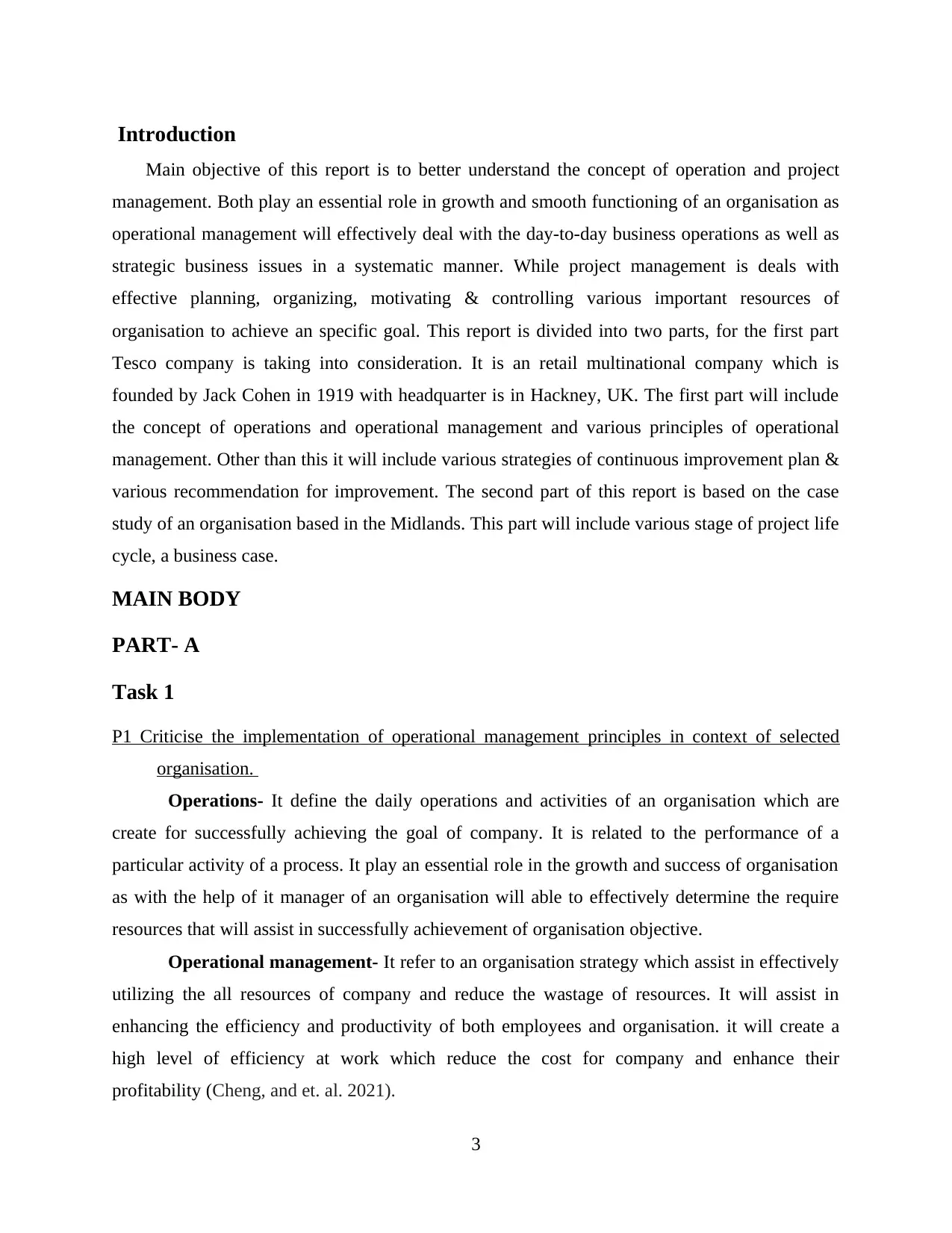
Introduction
Main objective of this report is to better understand the concept of operation and project
management. Both play an essential role in growth and smooth functioning of an organisation as
operational management will effectively deal with the day-to-day business operations as well as
strategic business issues in a systematic manner. While project management is deals with
effective planning, organizing, motivating & controlling various important resources of
organisation to achieve an specific goal. This report is divided into two parts, for the first part
Tesco company is taking into consideration. It is an retail multinational company which is
founded by Jack Cohen in 1919 with headquarter is in Hackney, UK. The first part will include
the concept of operations and operational management and various principles of operational
management. Other than this it will include various strategies of continuous improvement plan &
various recommendation for improvement. The second part of this report is based on the case
study of an organisation based in the Midlands. This part will include various stage of project life
cycle, a business case.
MAIN BODY
PART- A
Task 1
P1 Criticise the implementation of operational management principles in context of selected
organisation.
Operations- It define the daily operations and activities of an organisation which are
create for successfully achieving the goal of company. It is related to the performance of a
particular activity of a process. It play an essential role in the growth and success of organisation
as with the help of it manager of an organisation will able to effectively determine the require
resources that will assist in successfully achievement of organisation objective.
Operational management- It refer to an organisation strategy which assist in effectively
utilizing the all resources of company and reduce the wastage of resources. It will assist in
enhancing the efficiency and productivity of both employees and organisation. it will create a
high level of efficiency at work which reduce the cost for company and enhance their
profitability (Cheng, and et. al. 2021).
3
Main objective of this report is to better understand the concept of operation and project
management. Both play an essential role in growth and smooth functioning of an organisation as
operational management will effectively deal with the day-to-day business operations as well as
strategic business issues in a systematic manner. While project management is deals with
effective planning, organizing, motivating & controlling various important resources of
organisation to achieve an specific goal. This report is divided into two parts, for the first part
Tesco company is taking into consideration. It is an retail multinational company which is
founded by Jack Cohen in 1919 with headquarter is in Hackney, UK. The first part will include
the concept of operations and operational management and various principles of operational
management. Other than this it will include various strategies of continuous improvement plan &
various recommendation for improvement. The second part of this report is based on the case
study of an organisation based in the Midlands. This part will include various stage of project life
cycle, a business case.
MAIN BODY
PART- A
Task 1
P1 Criticise the implementation of operational management principles in context of selected
organisation.
Operations- It define the daily operations and activities of an organisation which are
create for successfully achieving the goal of company. It is related to the performance of a
particular activity of a process. It play an essential role in the growth and success of organisation
as with the help of it manager of an organisation will able to effectively determine the require
resources that will assist in successfully achievement of organisation objective.
Operational management- It refer to an organisation strategy which assist in effectively
utilizing the all resources of company and reduce the wastage of resources. It will assist in
enhancing the efficiency and productivity of both employees and organisation. it will create a
high level of efficiency at work which reduce the cost for company and enhance their
profitability (Cheng, and et. al. 2021).
3
⊘ This is a preview!⊘
Do you want full access?
Subscribe today to unlock all pages.

Trusted by 1+ million students worldwide
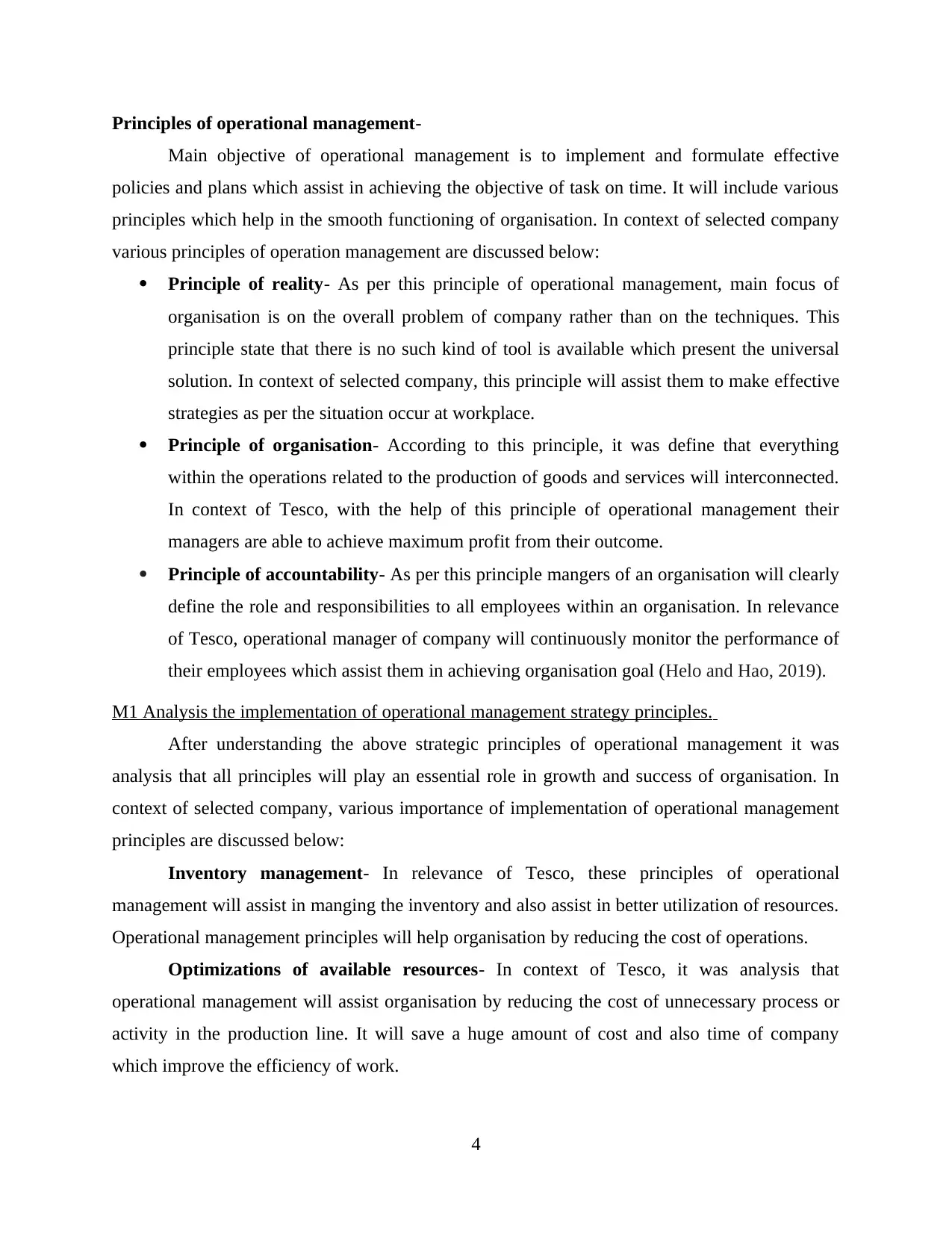
Principles of operational management-
Main objective of operational management is to implement and formulate effective
policies and plans which assist in achieving the objective of task on time. It will include various
principles which help in the smooth functioning of organisation. In context of selected company
various principles of operation management are discussed below:
Principle of reality- As per this principle of operational management, main focus of
organisation is on the overall problem of company rather than on the techniques. This
principle state that there is no such kind of tool is available which present the universal
solution. In context of selected company, this principle will assist them to make effective
strategies as per the situation occur at workplace.
Principle of organisation- According to this principle, it was define that everything
within the operations related to the production of goods and services will interconnected.
In context of Tesco, with the help of this principle of operational management their
managers are able to achieve maximum profit from their outcome.
Principle of accountability- As per this principle mangers of an organisation will clearly
define the role and responsibilities to all employees within an organisation. In relevance
of Tesco, operational manager of company will continuously monitor the performance of
their employees which assist them in achieving organisation goal (Helo and Hao, 2019).
M1 Analysis the implementation of operational management strategy principles.
After understanding the above strategic principles of operational management it was
analysis that all principles will play an essential role in growth and success of organisation. In
context of selected company, various importance of implementation of operational management
principles are discussed below:
Inventory management- In relevance of Tesco, these principles of operational
management will assist in manging the inventory and also assist in better utilization of resources.
Operational management principles will help organisation by reducing the cost of operations.
Optimizations of available resources- In context of Tesco, it was analysis that
operational management will assist organisation by reducing the cost of unnecessary process or
activity in the production line. It will save a huge amount of cost and also time of company
which improve the efficiency of work.
4
Main objective of operational management is to implement and formulate effective
policies and plans which assist in achieving the objective of task on time. It will include various
principles which help in the smooth functioning of organisation. In context of selected company
various principles of operation management are discussed below:
Principle of reality- As per this principle of operational management, main focus of
organisation is on the overall problem of company rather than on the techniques. This
principle state that there is no such kind of tool is available which present the universal
solution. In context of selected company, this principle will assist them to make effective
strategies as per the situation occur at workplace.
Principle of organisation- According to this principle, it was define that everything
within the operations related to the production of goods and services will interconnected.
In context of Tesco, with the help of this principle of operational management their
managers are able to achieve maximum profit from their outcome.
Principle of accountability- As per this principle mangers of an organisation will clearly
define the role and responsibilities to all employees within an organisation. In relevance
of Tesco, operational manager of company will continuously monitor the performance of
their employees which assist them in achieving organisation goal (Helo and Hao, 2019).
M1 Analysis the implementation of operational management strategy principles.
After understanding the above strategic principles of operational management it was
analysis that all principles will play an essential role in growth and success of organisation. In
context of selected company, various importance of implementation of operational management
principles are discussed below:
Inventory management- In relevance of Tesco, these principles of operational
management will assist in manging the inventory and also assist in better utilization of resources.
Operational management principles will help organisation by reducing the cost of operations.
Optimizations of available resources- In context of Tesco, it was analysis that
operational management will assist organisation by reducing the cost of unnecessary process or
activity in the production line. It will save a huge amount of cost and also time of company
which improve the efficiency of work.
4
Paraphrase This Document
Need a fresh take? Get an instant paraphrase of this document with our AI Paraphraser
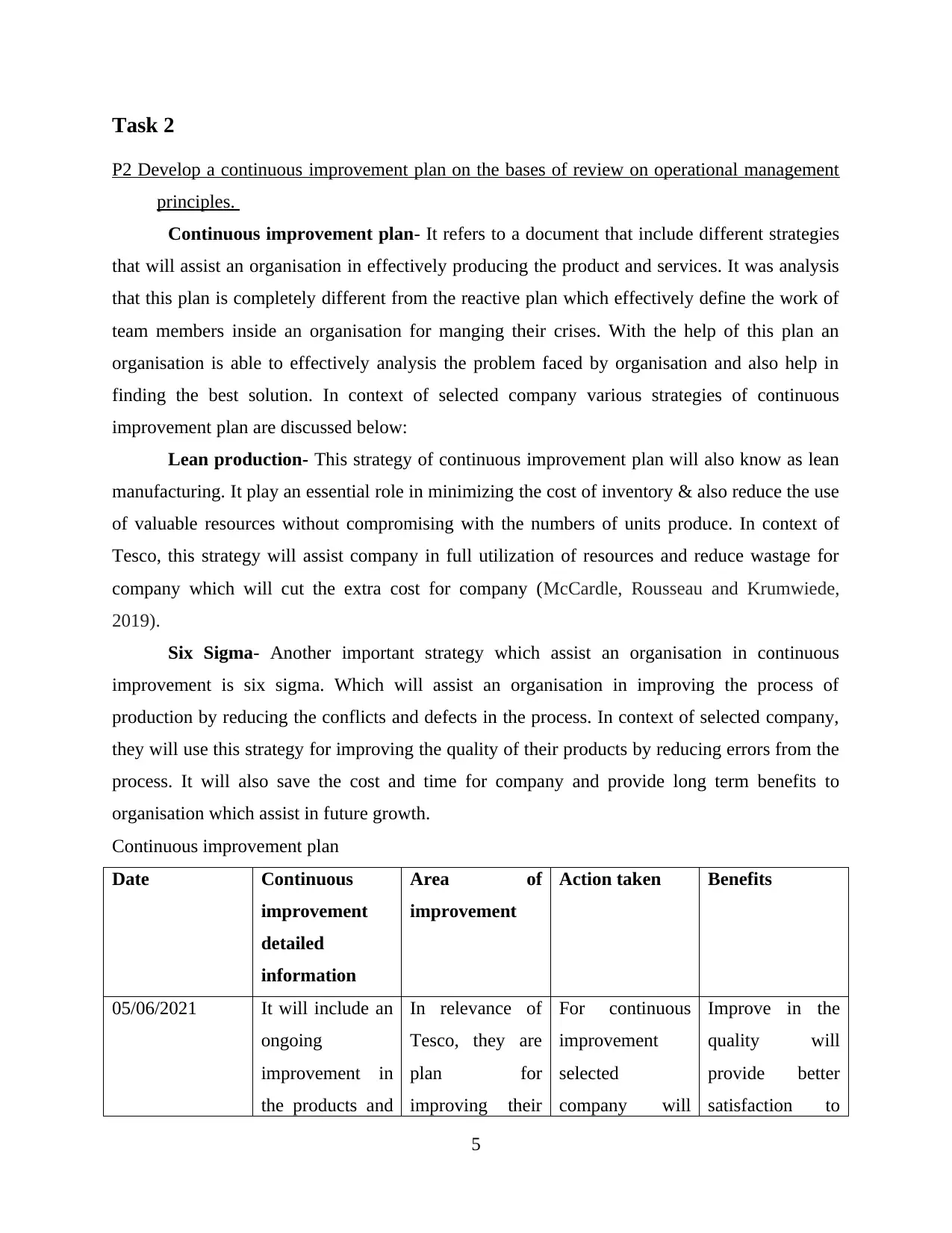
Task 2
P2 Develop a continuous improvement plan on the bases of review on operational management
principles.
Continuous improvement plan- It refers to a document that include different strategies
that will assist an organisation in effectively producing the product and services. It was analysis
that this plan is completely different from the reactive plan which effectively define the work of
team members inside an organisation for manging their crises. With the help of this plan an
organisation is able to effectively analysis the problem faced by organisation and also help in
finding the best solution. In context of selected company various strategies of continuous
improvement plan are discussed below:
Lean production- This strategy of continuous improvement plan will also know as lean
manufacturing. It play an essential role in minimizing the cost of inventory & also reduce the use
of valuable resources without compromising with the numbers of units produce. In context of
Tesco, this strategy will assist company in full utilization of resources and reduce wastage for
company which will cut the extra cost for company (McCardle, Rousseau and Krumwiede,
2019).
Six Sigma- Another important strategy which assist an organisation in continuous
improvement is six sigma. Which will assist an organisation in improving the process of
production by reducing the conflicts and defects in the process. In context of selected company,
they will use this strategy for improving the quality of their products by reducing errors from the
process. It will also save the cost and time for company and provide long term benefits to
organisation which assist in future growth.
Continuous improvement plan
Date Continuous
improvement
detailed
information
Area of
improvement
Action taken Benefits
05/06/2021 It will include an
ongoing
improvement in
the products and
In relevance of
Tesco, they are
plan for
improving their
For continuous
improvement
selected
company will
Improve in the
quality will
provide better
satisfaction to
5
P2 Develop a continuous improvement plan on the bases of review on operational management
principles.
Continuous improvement plan- It refers to a document that include different strategies
that will assist an organisation in effectively producing the product and services. It was analysis
that this plan is completely different from the reactive plan which effectively define the work of
team members inside an organisation for manging their crises. With the help of this plan an
organisation is able to effectively analysis the problem faced by organisation and also help in
finding the best solution. In context of selected company various strategies of continuous
improvement plan are discussed below:
Lean production- This strategy of continuous improvement plan will also know as lean
manufacturing. It play an essential role in minimizing the cost of inventory & also reduce the use
of valuable resources without compromising with the numbers of units produce. In context of
Tesco, this strategy will assist company in full utilization of resources and reduce wastage for
company which will cut the extra cost for company (McCardle, Rousseau and Krumwiede,
2019).
Six Sigma- Another important strategy which assist an organisation in continuous
improvement is six sigma. Which will assist an organisation in improving the process of
production by reducing the conflicts and defects in the process. In context of selected company,
they will use this strategy for improving the quality of their products by reducing errors from the
process. It will also save the cost and time for company and provide long term benefits to
organisation which assist in future growth.
Continuous improvement plan
Date Continuous
improvement
detailed
information
Area of
improvement
Action taken Benefits
05/06/2021 It will include an
ongoing
improvement in
the products and
In relevance of
Tesco, they are
plan for
improving their
For continuous
improvement
selected
company will
Improve in the
quality will
provide better
satisfaction to
5
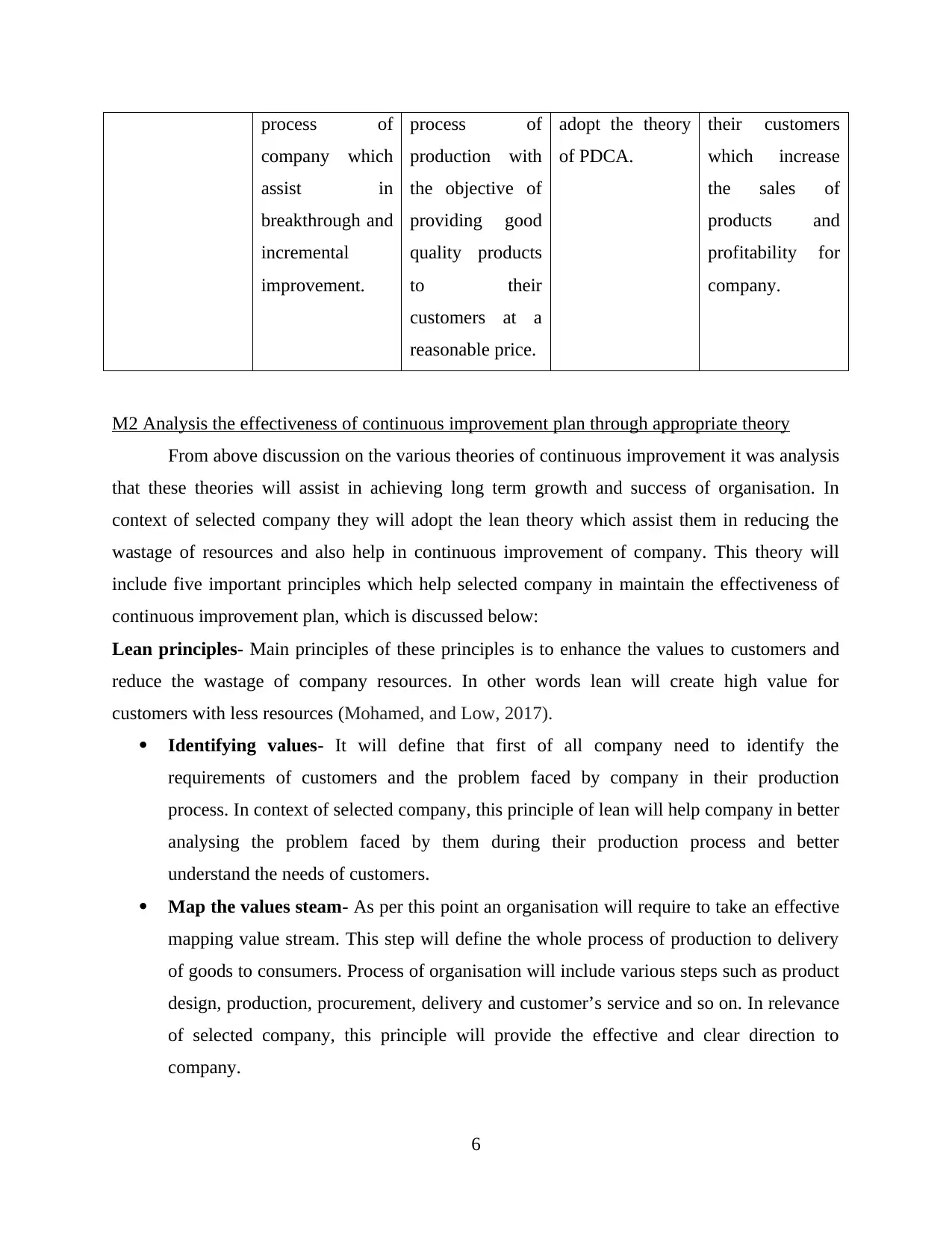
process of
company which
assist in
breakthrough and
incremental
improvement.
process of
production with
the objective of
providing good
quality products
to their
customers at a
reasonable price.
adopt the theory
of PDCA.
their customers
which increase
the sales of
products and
profitability for
company.
M2 Analysis the effectiveness of continuous improvement plan through appropriate theory
From above discussion on the various theories of continuous improvement it was analysis
that these theories will assist in achieving long term growth and success of organisation. In
context of selected company they will adopt the lean theory which assist them in reducing the
wastage of resources and also help in continuous improvement of company. This theory will
include five important principles which help selected company in maintain the effectiveness of
continuous improvement plan, which is discussed below:
Lean principles- Main principles of these principles is to enhance the values to customers and
reduce the wastage of company resources. In other words lean will create high value for
customers with less resources (Mohamed, and Low, 2017).
Identifying values- It will define that first of all company need to identify the
requirements of customers and the problem faced by company in their production
process. In context of selected company, this principle of lean will help company in better
analysing the problem faced by them during their production process and better
understand the needs of customers.
Map the values steam- As per this point an organisation will require to take an effective
mapping value stream. This step will define the whole process of production to delivery
of goods to consumers. Process of organisation will include various steps such as product
design, production, procurement, delivery and customer’s service and so on. In relevance
of selected company, this principle will provide the effective and clear direction to
company.
6
company which
assist in
breakthrough and
incremental
improvement.
process of
production with
the objective of
providing good
quality products
to their
customers at a
reasonable price.
adopt the theory
of PDCA.
their customers
which increase
the sales of
products and
profitability for
company.
M2 Analysis the effectiveness of continuous improvement plan through appropriate theory
From above discussion on the various theories of continuous improvement it was analysis
that these theories will assist in achieving long term growth and success of organisation. In
context of selected company they will adopt the lean theory which assist them in reducing the
wastage of resources and also help in continuous improvement of company. This theory will
include five important principles which help selected company in maintain the effectiveness of
continuous improvement plan, which is discussed below:
Lean principles- Main principles of these principles is to enhance the values to customers and
reduce the wastage of company resources. In other words lean will create high value for
customers with less resources (Mohamed, and Low, 2017).
Identifying values- It will define that first of all company need to identify the
requirements of customers and the problem faced by company in their production
process. In context of selected company, this principle of lean will help company in better
analysing the problem faced by them during their production process and better
understand the needs of customers.
Map the values steam- As per this point an organisation will require to take an effective
mapping value stream. This step will define the whole process of production to delivery
of goods to consumers. Process of organisation will include various steps such as product
design, production, procurement, delivery and customer’s service and so on. In relevance
of selected company, this principle will provide the effective and clear direction to
company.
6
⊘ This is a preview!⊘
Do you want full access?
Subscribe today to unlock all pages.

Trusted by 1+ million students worldwide
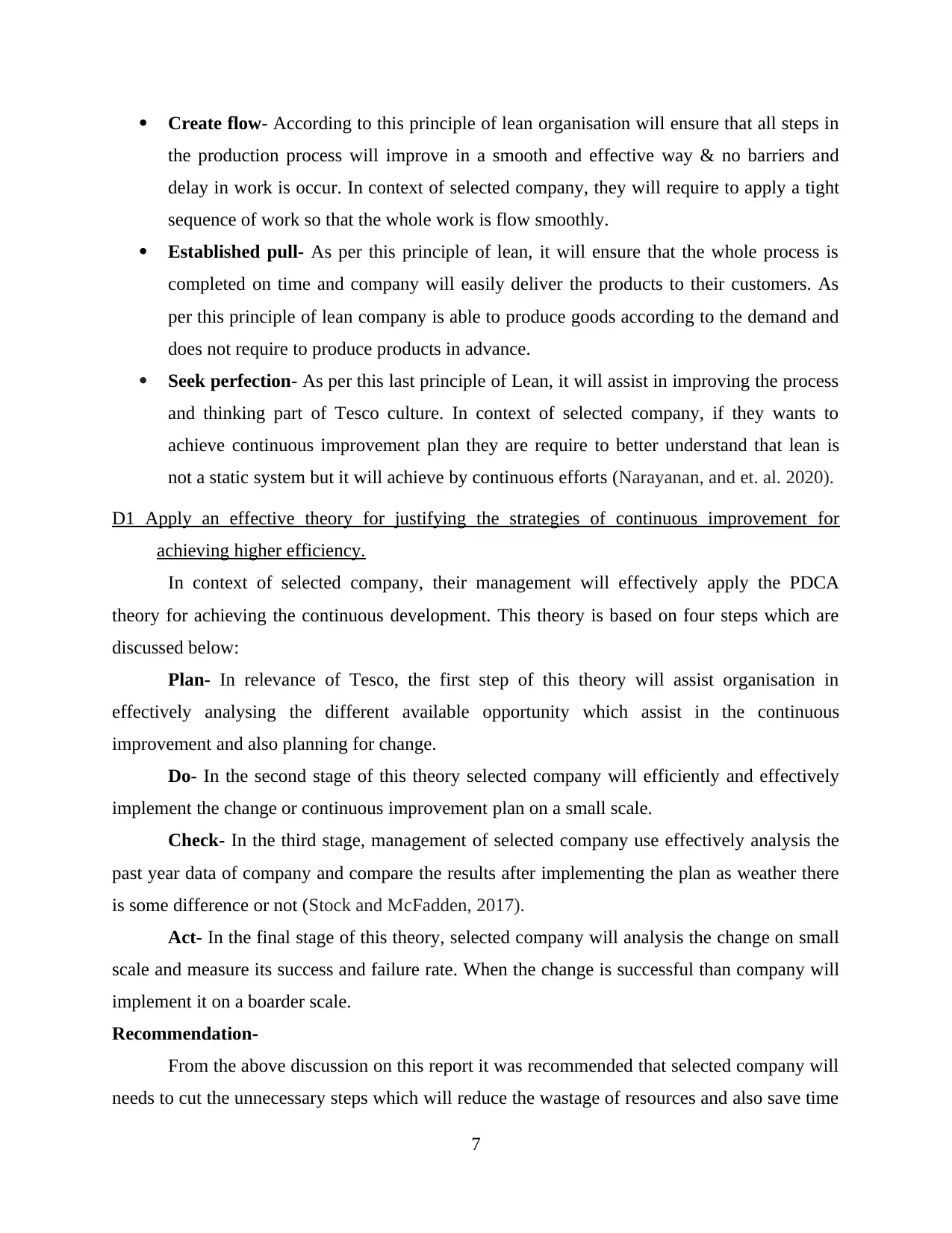
Create flow- According to this principle of lean organisation will ensure that all steps in
the production process will improve in a smooth and effective way & no barriers and
delay in work is occur. In context of selected company, they will require to apply a tight
sequence of work so that the whole work is flow smoothly.
Established pull- As per this principle of lean, it will ensure that the whole process is
completed on time and company will easily deliver the products to their customers. As
per this principle of lean company is able to produce goods according to the demand and
does not require to produce products in advance.
Seek perfection- As per this last principle of Lean, it will assist in improving the process
and thinking part of Tesco culture. In context of selected company, if they wants to
achieve continuous improvement plan they are require to better understand that lean is
not a static system but it will achieve by continuous efforts (Narayanan, and et. al. 2020).
D1 Apply an effective theory for justifying the strategies of continuous improvement for
achieving higher efficiency.
In context of selected company, their management will effectively apply the PDCA
theory for achieving the continuous development. This theory is based on four steps which are
discussed below:
Plan- In relevance of Tesco, the first step of this theory will assist organisation in
effectively analysing the different available opportunity which assist in the continuous
improvement and also planning for change.
Do- In the second stage of this theory selected company will efficiently and effectively
implement the change or continuous improvement plan on a small scale.
Check- In the third stage, management of selected company use effectively analysis the
past year data of company and compare the results after implementing the plan as weather there
is some difference or not (Stock and McFadden, 2017).
Act- In the final stage of this theory, selected company will analysis the change on small
scale and measure its success and failure rate. When the change is successful than company will
implement it on a boarder scale.
Recommendation-
From the above discussion on this report it was recommended that selected company will
needs to cut the unnecessary steps which will reduce the wastage of resources and also save time
7
the production process will improve in a smooth and effective way & no barriers and
delay in work is occur. In context of selected company, they will require to apply a tight
sequence of work so that the whole work is flow smoothly.
Established pull- As per this principle of lean, it will ensure that the whole process is
completed on time and company will easily deliver the products to their customers. As
per this principle of lean company is able to produce goods according to the demand and
does not require to produce products in advance.
Seek perfection- As per this last principle of Lean, it will assist in improving the process
and thinking part of Tesco culture. In context of selected company, if they wants to
achieve continuous improvement plan they are require to better understand that lean is
not a static system but it will achieve by continuous efforts (Narayanan, and et. al. 2020).
D1 Apply an effective theory for justifying the strategies of continuous improvement for
achieving higher efficiency.
In context of selected company, their management will effectively apply the PDCA
theory for achieving the continuous development. This theory is based on four steps which are
discussed below:
Plan- In relevance of Tesco, the first step of this theory will assist organisation in
effectively analysing the different available opportunity which assist in the continuous
improvement and also planning for change.
Do- In the second stage of this theory selected company will efficiently and effectively
implement the change or continuous improvement plan on a small scale.
Check- In the third stage, management of selected company use effectively analysis the
past year data of company and compare the results after implementing the plan as weather there
is some difference or not (Stock and McFadden, 2017).
Act- In the final stage of this theory, selected company will analysis the change on small
scale and measure its success and failure rate. When the change is successful than company will
implement it on a boarder scale.
Recommendation-
From the above discussion on this report it was recommended that selected company will
needs to cut the unnecessary steps which will reduce the wastage of resources and also save time
7
Paraphrase This Document
Need a fresh take? Get an instant paraphrase of this document with our AI Paraphraser

for company. Other than this it was recommended that company will require to build good
relation with their customers so that they will better analysis their requirements (Thaler,
Löschner and Hartmann, 2017).
8
relation with their customers so that they will better analysis their requirements (Thaler,
Löschner and Hartmann, 2017).
8
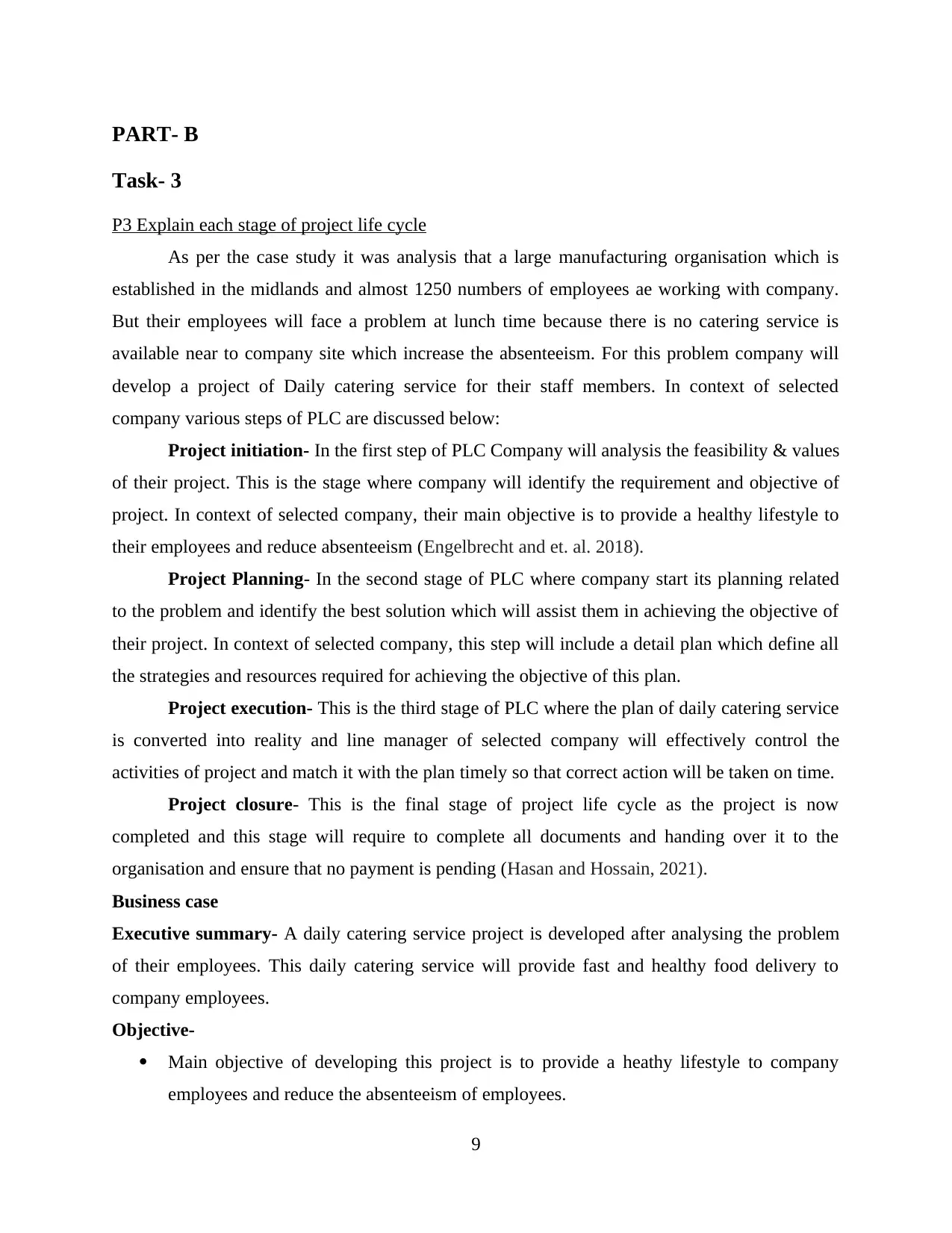
PART- B
Task- 3
P3 Explain each stage of project life cycle
As per the case study it was analysis that a large manufacturing organisation which is
established in the midlands and almost 1250 numbers of employees ae working with company.
But their employees will face a problem at lunch time because there is no catering service is
available near to company site which increase the absenteeism. For this problem company will
develop a project of Daily catering service for their staff members. In context of selected
company various steps of PLC are discussed below:
Project initiation- In the first step of PLC Company will analysis the feasibility & values
of their project. This is the stage where company will identify the requirement and objective of
project. In context of selected company, their main objective is to provide a healthy lifestyle to
their employees and reduce absenteeism (Engelbrecht and et. al. 2018).
Project Planning- In the second stage of PLC where company start its planning related
to the problem and identify the best solution which will assist them in achieving the objective of
their project. In context of selected company, this step will include a detail plan which define all
the strategies and resources required for achieving the objective of this plan.
Project execution- This is the third stage of PLC where the plan of daily catering service
is converted into reality and line manager of selected company will effectively control the
activities of project and match it with the plan timely so that correct action will be taken on time.
Project closure- This is the final stage of project life cycle as the project is now
completed and this stage will require to complete all documents and handing over it to the
organisation and ensure that no payment is pending (Hasan and Hossain, 2021).
Business case
Executive summary- A daily catering service project is developed after analysing the problem
of their employees. This daily catering service will provide fast and healthy food delivery to
company employees.
Objective-
Main objective of developing this project is to provide a heathy lifestyle to company
employees and reduce the absenteeism of employees.
9
Task- 3
P3 Explain each stage of project life cycle
As per the case study it was analysis that a large manufacturing organisation which is
established in the midlands and almost 1250 numbers of employees ae working with company.
But their employees will face a problem at lunch time because there is no catering service is
available near to company site which increase the absenteeism. For this problem company will
develop a project of Daily catering service for their staff members. In context of selected
company various steps of PLC are discussed below:
Project initiation- In the first step of PLC Company will analysis the feasibility & values
of their project. This is the stage where company will identify the requirement and objective of
project. In context of selected company, their main objective is to provide a healthy lifestyle to
their employees and reduce absenteeism (Engelbrecht and et. al. 2018).
Project Planning- In the second stage of PLC where company start its planning related
to the problem and identify the best solution which will assist them in achieving the objective of
their project. In context of selected company, this step will include a detail plan which define all
the strategies and resources required for achieving the objective of this plan.
Project execution- This is the third stage of PLC where the plan of daily catering service
is converted into reality and line manager of selected company will effectively control the
activities of project and match it with the plan timely so that correct action will be taken on time.
Project closure- This is the final stage of project life cycle as the project is now
completed and this stage will require to complete all documents and handing over it to the
organisation and ensure that no payment is pending (Hasan and Hossain, 2021).
Business case
Executive summary- A daily catering service project is developed after analysing the problem
of their employees. This daily catering service will provide fast and healthy food delivery to
company employees.
Objective-
Main objective of developing this project is to provide a heathy lifestyle to company
employees and reduce the absenteeism of employees.
9
⊘ This is a preview!⊘
Do you want full access?
Subscribe today to unlock all pages.

Trusted by 1+ million students worldwide
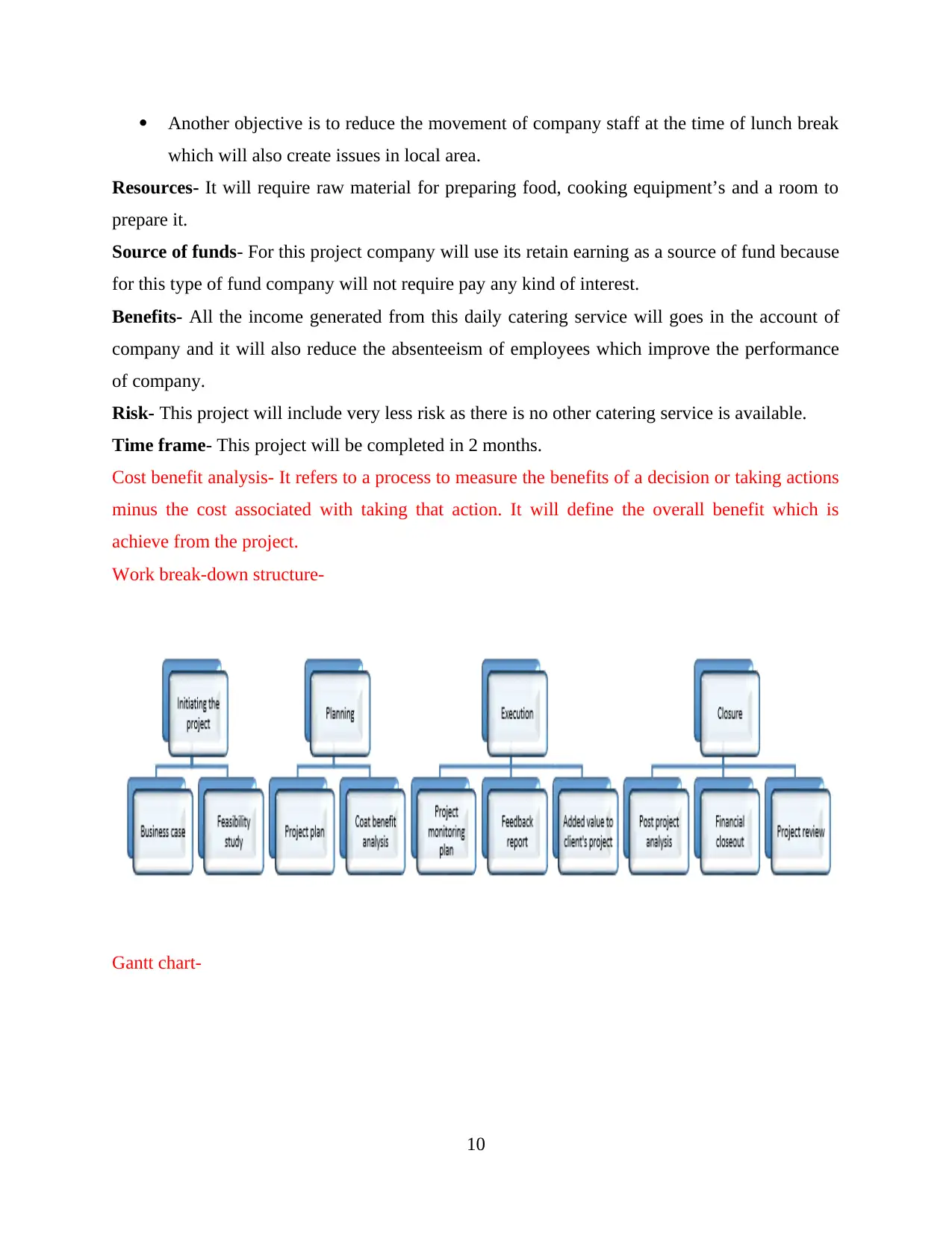
Another objective is to reduce the movement of company staff at the time of lunch break
which will also create issues in local area.
Resources- It will require raw material for preparing food, cooking equipment’s and a room to
prepare it.
Source of funds- For this project company will use its retain earning as a source of fund because
for this type of fund company will not require pay any kind of interest.
Benefits- All the income generated from this daily catering service will goes in the account of
company and it will also reduce the absenteeism of employees which improve the performance
of company.
Risk- This project will include very less risk as there is no other catering service is available.
Time frame- This project will be completed in 2 months.
Cost benefit analysis- It refers to a process to measure the benefits of a decision or taking actions
minus the cost associated with taking that action. It will define the overall benefit which is
achieve from the project.
Work break-down structure-
Gantt chart-
10
which will also create issues in local area.
Resources- It will require raw material for preparing food, cooking equipment’s and a room to
prepare it.
Source of funds- For this project company will use its retain earning as a source of fund because
for this type of fund company will not require pay any kind of interest.
Benefits- All the income generated from this daily catering service will goes in the account of
company and it will also reduce the absenteeism of employees which improve the performance
of company.
Risk- This project will include very less risk as there is no other catering service is available.
Time frame- This project will be completed in 2 months.
Cost benefit analysis- It refers to a process to measure the benefits of a decision or taking actions
minus the cost associated with taking that action. It will define the overall benefit which is
achieve from the project.
Work break-down structure-
Gantt chart-
10
Paraphrase This Document
Need a fresh take? Get an instant paraphrase of this document with our AI Paraphraser
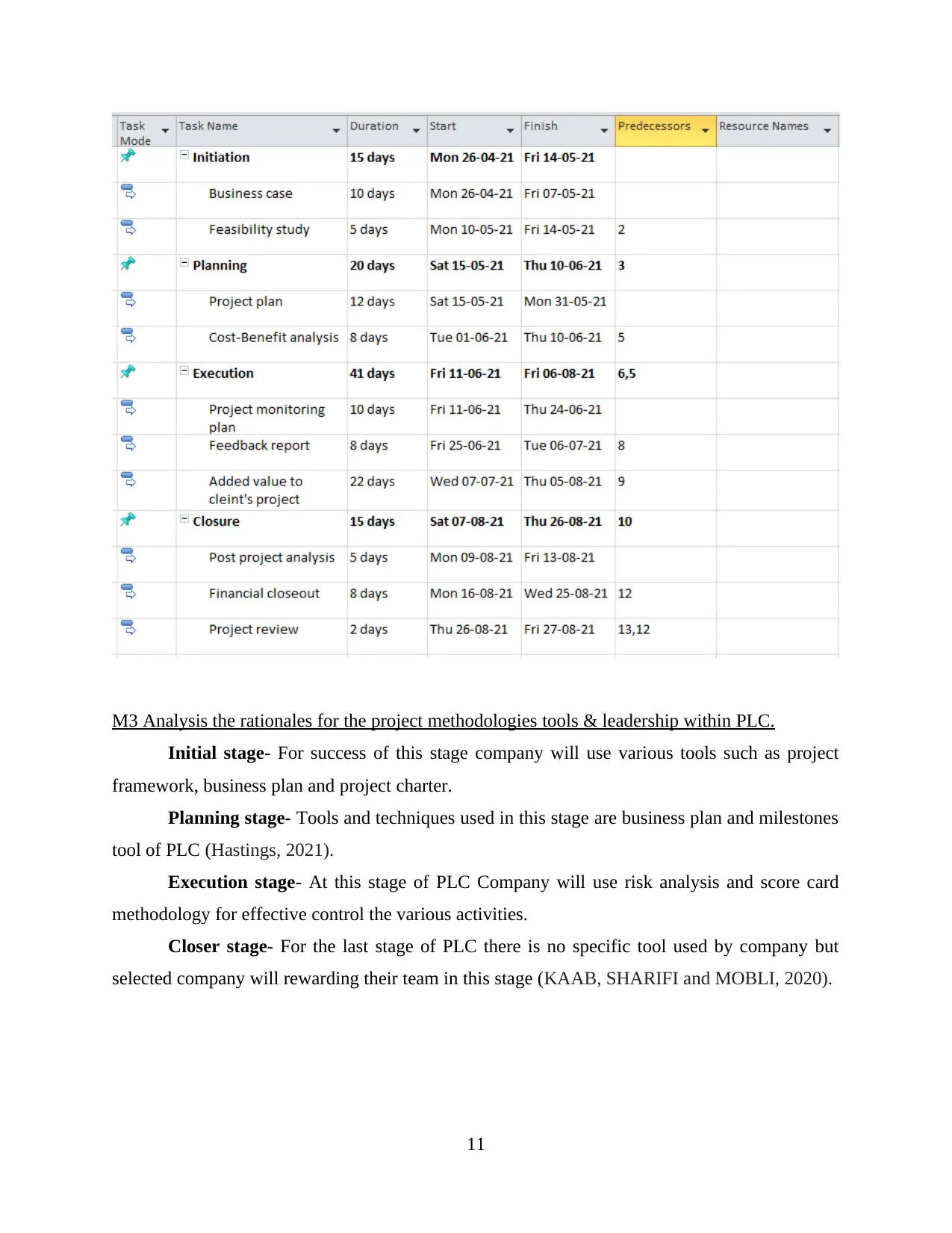
M3 Analysis the rationales for the project methodologies tools & leadership within PLC.
Initial stage- For success of this stage company will use various tools such as project
framework, business plan and project charter.
Planning stage- Tools and techniques used in this stage are business plan and milestones
tool of PLC (Hastings, 2021).
Execution stage- At this stage of PLC Company will use risk analysis and score card
methodology for effective control the various activities.
Closer stage- For the last stage of PLC there is no specific tool used by company but
selected company will rewarding their team in this stage (KAAB, SHARIFI and MOBLI, 2020).
11
Initial stage- For success of this stage company will use various tools such as project
framework, business plan and project charter.
Planning stage- Tools and techniques used in this stage are business plan and milestones
tool of PLC (Hastings, 2021).
Execution stage- At this stage of PLC Company will use risk analysis and score card
methodology for effective control the various activities.
Closer stage- For the last stage of PLC there is no specific tool used by company but
selected company will rewarding their team in this stage (KAAB, SHARIFI and MOBLI, 2020).
11
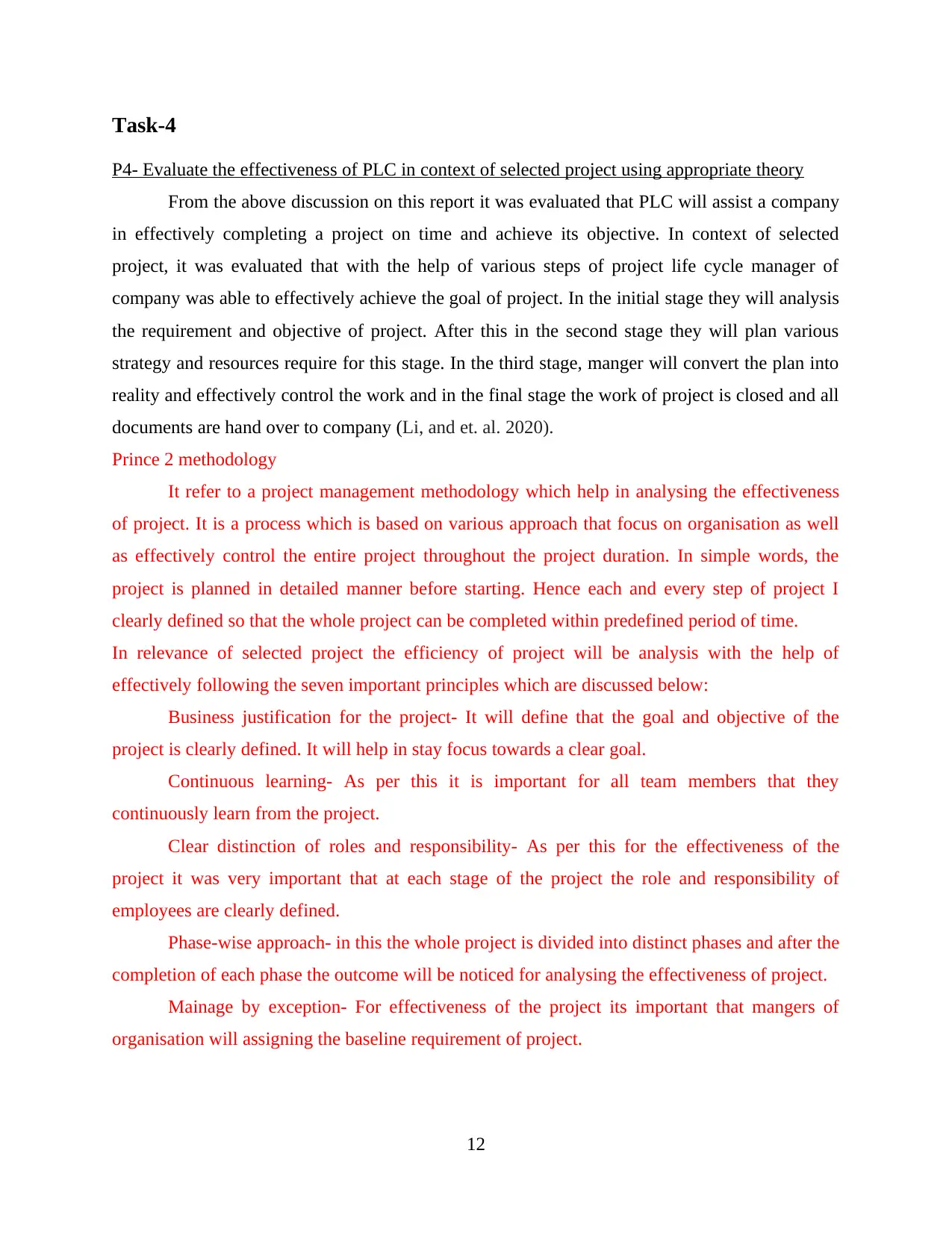
Task-4
P4- Evaluate the effectiveness of PLC in context of selected project using appropriate theory
From the above discussion on this report it was evaluated that PLC will assist a company
in effectively completing a project on time and achieve its objective. In context of selected
project, it was evaluated that with the help of various steps of project life cycle manager of
company was able to effectively achieve the goal of project. In the initial stage they will analysis
the requirement and objective of project. After this in the second stage they will plan various
strategy and resources require for this stage. In the third stage, manger will convert the plan into
reality and effectively control the work and in the final stage the work of project is closed and all
documents are hand over to company (Li, and et. al. 2020).
Prince 2 methodology
It refer to a project management methodology which help in analysing the effectiveness
of project. It is a process which is based on various approach that focus on organisation as well
as effectively control the entire project throughout the project duration. In simple words, the
project is planned in detailed manner before starting. Hence each and every step of project I
clearly defined so that the whole project can be completed within predefined period of time.
In relevance of selected project the efficiency of project will be analysis with the help of
effectively following the seven important principles which are discussed below:
Business justification for the project- It will define that the goal and objective of the
project is clearly defined. It will help in stay focus towards a clear goal.
Continuous learning- As per this it is important for all team members that they
continuously learn from the project.
Clear distinction of roles and responsibility- As per this for the effectiveness of the
project it was very important that at each stage of the project the role and responsibility of
employees are clearly defined.
Phase-wise approach- in this the whole project is divided into distinct phases and after the
completion of each phase the outcome will be noticed for analysing the effectiveness of project.
Mainage by exception- For effectiveness of the project its important that mangers of
organisation will assigning the baseline requirement of project.
12
P4- Evaluate the effectiveness of PLC in context of selected project using appropriate theory
From the above discussion on this report it was evaluated that PLC will assist a company
in effectively completing a project on time and achieve its objective. In context of selected
project, it was evaluated that with the help of various steps of project life cycle manager of
company was able to effectively achieve the goal of project. In the initial stage they will analysis
the requirement and objective of project. After this in the second stage they will plan various
strategy and resources require for this stage. In the third stage, manger will convert the plan into
reality and effectively control the work and in the final stage the work of project is closed and all
documents are hand over to company (Li, and et. al. 2020).
Prince 2 methodology
It refer to a project management methodology which help in analysing the effectiveness
of project. It is a process which is based on various approach that focus on organisation as well
as effectively control the entire project throughout the project duration. In simple words, the
project is planned in detailed manner before starting. Hence each and every step of project I
clearly defined so that the whole project can be completed within predefined period of time.
In relevance of selected project the efficiency of project will be analysis with the help of
effectively following the seven important principles which are discussed below:
Business justification for the project- It will define that the goal and objective of the
project is clearly defined. It will help in stay focus towards a clear goal.
Continuous learning- As per this it is important for all team members that they
continuously learn from the project.
Clear distinction of roles and responsibility- As per this for the effectiveness of the
project it was very important that at each stage of the project the role and responsibility of
employees are clearly defined.
Phase-wise approach- in this the whole project is divided into distinct phases and after the
completion of each phase the outcome will be noticed for analysing the effectiveness of project.
Mainage by exception- For effectiveness of the project its important that mangers of
organisation will assigning the baseline requirement of project.
12
⊘ This is a preview!⊘
Do you want full access?
Subscribe today to unlock all pages.

Trusted by 1+ million students worldwide
1 out of 15
Related Documents
Your All-in-One AI-Powered Toolkit for Academic Success.
+13062052269
info@desklib.com
Available 24*7 on WhatsApp / Email
![[object Object]](/_next/static/media/star-bottom.7253800d.svg)
Unlock your academic potential
Copyright © 2020–2025 A2Z Services. All Rights Reserved. Developed and managed by ZUCOL.





